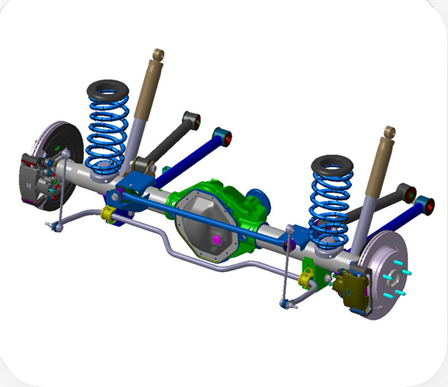The Twist-beam rear suspension is a similar suspension design, however its beam axle is able to twist, thereby functioning as an anti-roll bar to control the roll motion of the body, and is considered to be a semi-independent suspension design.
Advantages of a rigid axle:
- Typically simple in design, rugged, and inexpensive to manufacture.
- Only one universal joint or constant-velocity joint is needed at each steered and driven drive wheel and none are needed at non-steered wheels; this reduces maintenance requirements and manufacturing costs compared to independent suspensions, which typically require two such joints at each driven wheel.
- A beam axle is space-efficient, an important advantage for off-road applications, as it provides better vehicle articulation and durability in a high load environment.
- Camber angle is rigidly fixed by axle geometry.
- Wheel alignment is simplified.
- Traction, braking and tire wear characteristics do not change as the suspension is compressed. These are great benefits in a vehicle that carries heavy loads, and together with the beam axle's characteristic strength, this has resulted in front and rear beam axles being nearly universal in buses and heavy-duty trucks. Most light and medium duty pickup trucks, SUVs, and vans also use a beam axle, at least in the rear.
Disadvantages of a rigid axle:
- A beam axle does not allow each wheel to move independently in response to uneven surfaces, and handling is typically worse than more sophisticated suspension designs.
- In turns, the outside wheel is often subjected to adverse camber angles when the inside wheel hits a bump, which can suddenly reduce cornering grip and destabilize the vehicle.
- Camber angle cannot change during body roll, and the geometric roll center of the suspension is always fixed at the physical axle midpoint, limiting suspension tuning options. Furthermore, the roll center moves in reaction to road irregularities
- The mass of the beam is part of the unsprung weight of the vehicle, hurting ride quality.
- The bulky differential housing reduces ground clearance, hindering the vehicle's ability to ford deep mud, clear obstacles and negotiate deeply rutted roads.
- The differential housing can only be raised by using larger wheels and tires, typically with a penalty in unsprung weight, braking effectiveness and acquisition costs; furthermore, vehicle modifications may be necessary for adequate fender or frame clearance.
- Front beam axle suspension is unusually sensitive to any lack of concentricity in the hub and wheel assembly which can cause a side-to-side oscillation ("shimmy") of the steering at certain speeds (typically 60–80 kilometres per hour (40–50 mph)), commonly referred to as "death wobble" within the 4x4 community. This is addressed on some vehicles with steering dampers although removal and careful refitting of the front wheels often cures the problem.
Source:
https://en.wikipedia.org/wiki/Beam_axle
https://second.wiki/wiki/suspensic3b3n_dependiente
https://commons.wikimedia.org/w/index.php?curid=3368835
edited by: ascari



